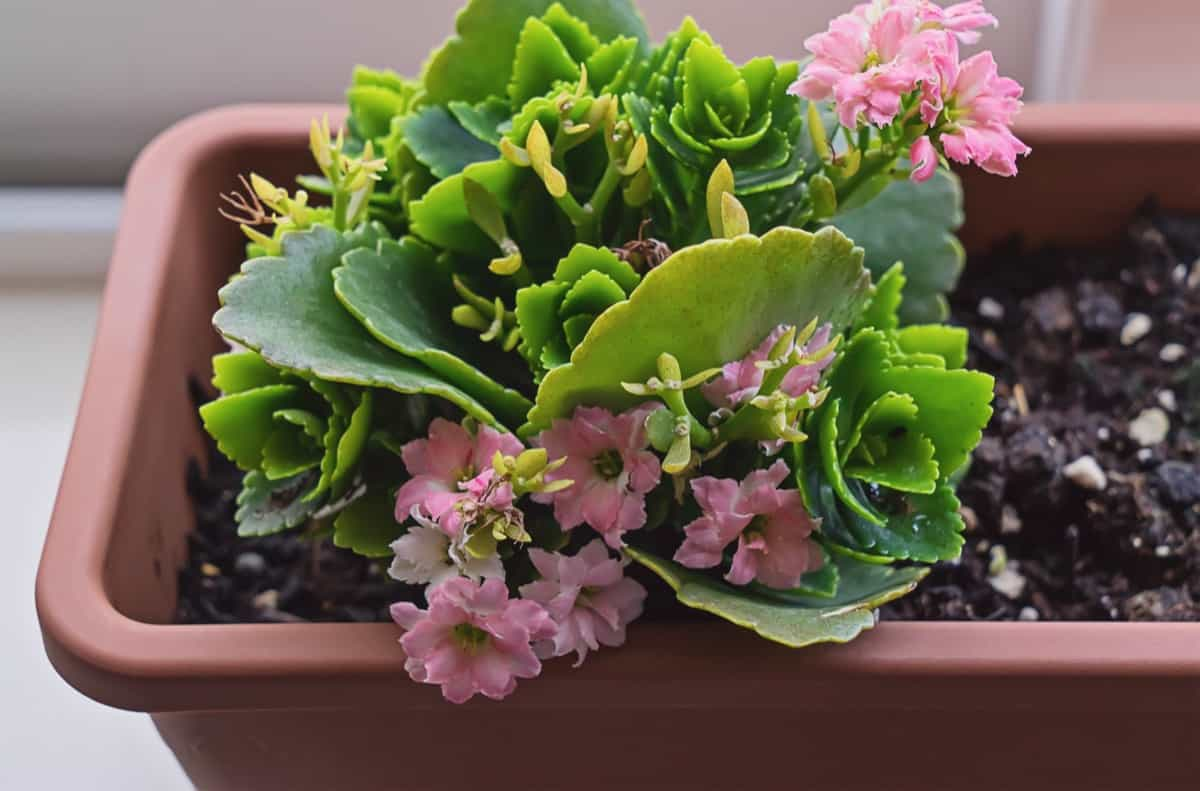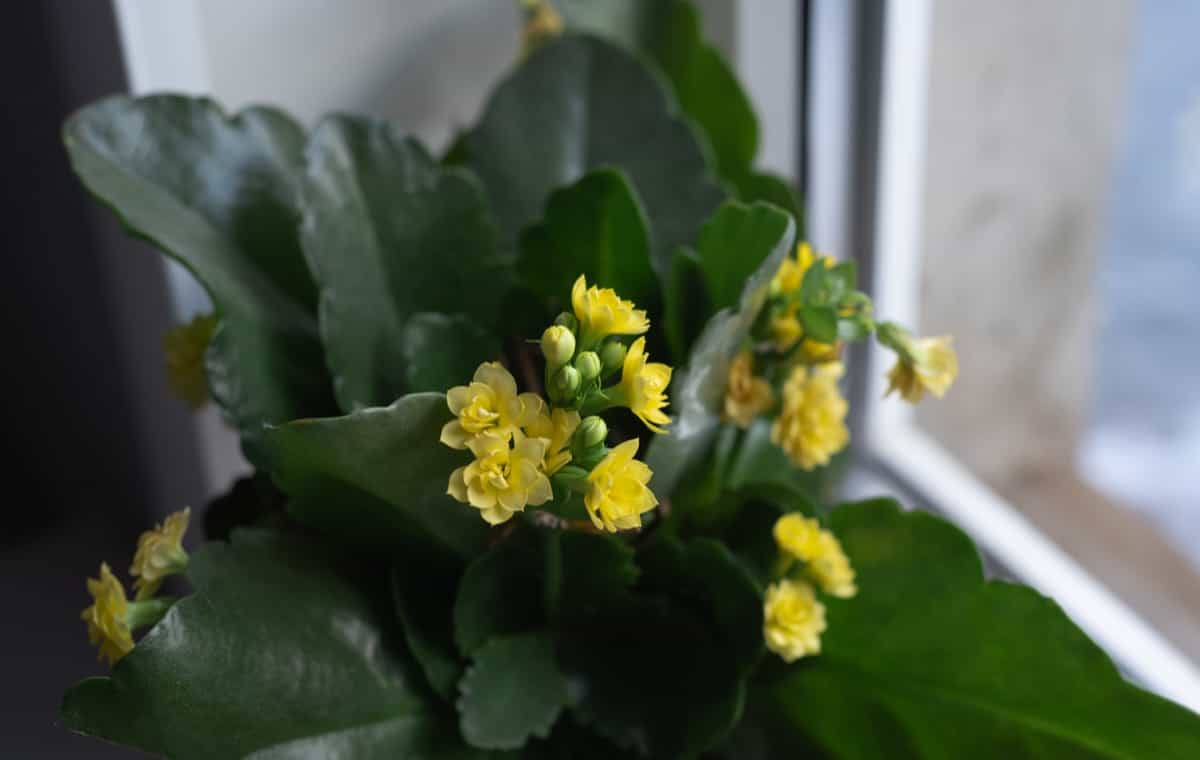Kalanchoes are known for their vibrant, long-lasting blooms and thick, fleshy leaves, making them popular choices for indoor and outdoor gardens alike. With the right care regimen, you can help your struggling Kalanchoe recover and thrive once again. In this guide, we’ll explore the essential steps to reviving dying Kalanchoe.

How to Revive a Dying Kalanchoe
Assess the Situation
Identify Symptoms
- Yellowing Leaves: As dying Kalanchoe signs, yellowing leaves can indicate overwatering, underwatering, or nutrient deficiencies.
- Wilting or Drooping: This can be caused by both overwatering and underwatering. Check the moisture to determine the cause.
- Leaf Drop: If the Kalanchoe plant is losing leaves, it could be due to stress from improper watering, lighting, or environmental conditions.
- Root Rot: If the roots are mushy, dark, or have a foul odor, your plant may be suffering from root rot, usually caused by overwatering.
- Stunted Growth: Lack of growth can indicate insufficient light, poor soil conditions, or nutrient deficiencies.
Check for Pests and Diseases
Pest Inspection
Examine the plant thoroughly, particularly under leaves and along stems, for signs of pests such as aphids, mealybugs, or spider mites. These can weaken the plant and inhibit growth. As Kalanchoe pest remedy, treat pests with insecticidal soap or neem oil, applying according to instructions.
Disease Identification
Look for symptoms like yellowing or spotted leaves, wilting, or mold growth, which could indicate fungal or bacterial diseases. Overwatering or poor air circulation can contribute to these issues. For fungal diseases, remove affected parts and improve air circulation around the plant. Avoid overwatering, as damp conditions exacerbate many issues. Additionally, repot the Kalanchoe if it’s root-bound, using fresh, well-draining soil. Provide appropriate light and temperature conditions for saving wilting kalanchoe.
In case you missed it: How to Use Neem Oil on Kalanchoe Plants: Natural Way to Control and Prevent Pests

Adjust Watering Practices
Overwatering Correction
If your Kalanchoe is suffering from overwatering, allow the soil to dry before watering again. Ensure proper drainage in the pot, and for the Kalanchoe root rot fix, consider repotting if necessary to prevent waterlogging and overwatered Kalanchoe recovery.
Underwatering Recovery
As underwatered Kalanchoe help, gradually increase watering frequency, but be cautious not to drown the plant. Ensure the soil is thoroughly moistened during each watering session, but allow excess water to drain away. For Kalanchoe dehydration solutions, assess the moisture by inserting a finger into the soil; if it is dry an inch deep, it’s time to water. Maintain a balance between moisture and dryness to support the Kalanchoe’s recovery.
Optimize Light Exposure
Increase Sunlight
Kalanchoe plants thrive in bright, indirect sunlight. Place your dying Kalanchoe near a sunny window where it receives plenty of natural light throughout the day. If indoors, consider moving it to a spot with the most sunlight exposure for Kalanchoe yellow leaves treatment.
Prevent Sunburn
While Kalanchoes enjoy sunlight, they can easily get sunburned if exposed to intense sunlight for too long, especially during hot summer months. To prevent this, provide filtered sunlight during the hottest parts of the day or use sheer curtains to diffuse the light. If moving outdoors, gradually acclimate the plant to direct sunlight to avoid shock.
Regulate Temperature and Humidity
Ideal Conditions
Regulate temperature and humidity to provide ideal conditions for its recovery. Maintain temperatures between 15-29°C, avoiding extreme heat or cold. Kalanchoes thrive in moderate humidity levels, around 40-50%. Place a humidity tray nearby or mist the plant regularly to create a suitable environment.
In case you missed it: How to Grow Kalanchoe in 12 Steps: Propagation, Pruning, Care for More Blooms

Improve Soil Condition
Repotting
Transplanting your kalanchoe into fresh soil can work wonders for its revival. Choose a well-draining potting mix designed for succulents to avoid waterlogging, which leads to root rot. Gently remove the kalanchoe plant from its current pot, shake off excess soil, and replant it into a bigger container filled with fresh potting soil. This Kalanchoe wilt treatment helps refresh the root system and provides the plant with a healthier environment.
Soil Amendments
Enhancing the soil with appropriate amendments can revitalize your kalanchoe’s health. Incorporate organic matter such as vermicompost or well-aged manure into the potting mix to improve soil structure and nutrient content. Additionally, adding perlite or coarse sand can further improve drainage, preventing water stagnation around the roots. Ensure the soil pH is suitable for kalanchoes, ideally slightly acidic to neutral. Monitoring and adjusting soil conditions can significantly contribute to the plant’s recovery and overall well-being.
Fertilize Appropriately
Balanced Nutrition
Begin with balanced nutrition by fertilizing appropriately. Choose a fertilizer with equal parts nitrogen, phosphorus, and potassium (10-10-10) to support overall plant health. Apply the fertilizer as per package instructions, typically 2-4 weeks during the season. Ensure not to over-fertilize, as this can harm the plant.
Monitor the Kalanchoe for signs of improvement, such as increased leaf growth or vibrant blooms. Adjust the fertilizer regimen as needed based on the plant’s response. With consistent and proper fertilization, you can encourage the Kalanchoe to rebound and thrive once again.
Prune Damaged Parts
Remove Dead Tissue
Begin by pruning damaged parts to encourage new growth. Trim away any dead tissue, including wilted leaves or stems, using clean, sharp scissors or pruning shears. Be sure to cut back to healthy tissue to prevent further decay. Removing dead parts allows the plant to focus its energy on rejuvenating itself. After pruning, provide optimal growing conditions such as adequate sunlight, well-draining soil, and proper watering. With consistent care and patience, your Kalanchoe has a good chance of bouncing back to vibrant health.
Implement Stress Recovery Techniques
Gradual Adjustment
Initiate gradual adjustments to its environment for improving Kalanchoe health. Sudden changes in light, temperature, or watering can stress the plant further. Begin by moving it to a location with filtered sunlight, avoiding direct exposure. Adjust watering frequency and quantity gradually, ensuring the soil is neither too dry nor waterlogged. Introduce fertilizer in diluted amounts to provide essential nutrients without overwhelming the weakened plant.
Patience and Observation
Exercise patience during the revival process. A stressed Kalanchoe may not show immediate improvement. Observe the recovery from Kalanchoe stress symptoms, such as new growth or healthier leaves. Remove any dead or yellowing parts to redirect energy toward rejuvenation. Regularly rehydrating dry Kalanchoe and adjust watering accordingly.
In case you missed it: 10 Reasons Why Your Fruit Tree is Not Producing Flowers: Remedies and Treatment

Utilize this period of observation to understand the specific needs of your Kalanchoe and tailor care accordingly. Remember that recovery is a gradual process, and consistent, attentive care will yield positive results over time.
Conclusion
Rejuvenating sick Kalanchoe can be a rewarding process, but it requires patience, diligence, and proper care. By following these Kalanchoe recovery steps, you can significantly increase the chances of bringing your Kalanchoe back to life. Remember, every plant is different, and it may take some trial and error to find the perfect care routine for your Kalanchoe. With love, attention, and proper care, your Kalanchoe has a good chance of thriving once again.
- Feed Your Flock for Less: Top 10 Tips to Save on Chicken Feed
- Ultimate Guide to Ossabaw Island Hog: Breeding, Raising, Diet, and Care
- Hatching Answers: The Top 10 Reasons Your Chickens Aren’t Laying Eggs
- Eggs and Economics: Breaking Down the Cost of Raising Backyard Chickens
- Defend Your Greens: Proven Methods to Keep Iguanas Out of Your Garden
- Ultimate Guide to Cinnamon Queen Chicken: A Comprehensive Guide for Beginners
- Ultimate Guide to California Tan Chicken: Breeding, Raising, Diet, Egg-Production and Care
- Ultimate Guide to Marsh Daisy Chicken: Breeding, Raising, Diet, and Care
- 10 Types of Chicken Farming Businesses You Can Start for Profits